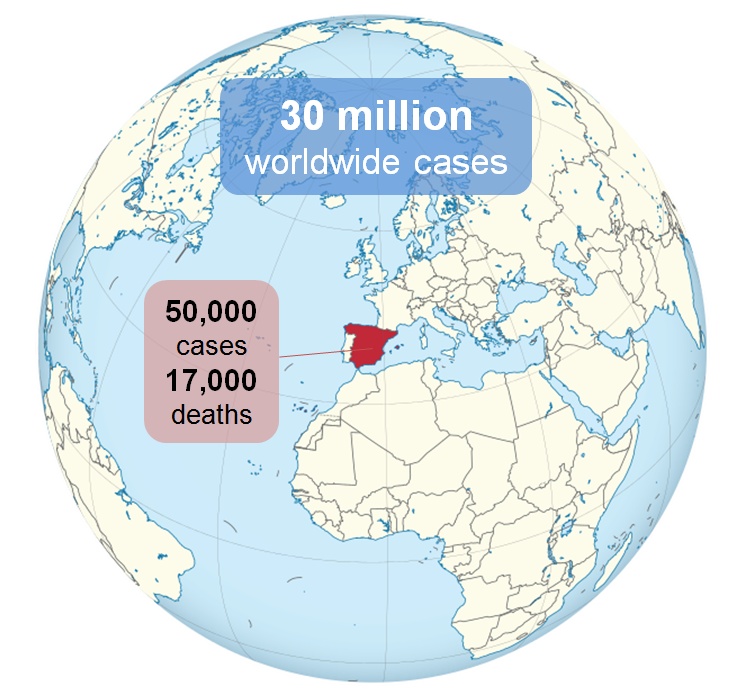- Anna Ullastres
- no comments
Abstract
Sepsis is a life-threatening condition arising from an infection, mostly caused by gram-negative and gram-positive bacteria. Sepsis can potentially lead to multiple organ failure and death, especially in young children, elderly people, or people with impaired immune systems. Experts estimate a 2% increase in sepsis mortality rates in the next years. Developing countries are facing new risk factors, such as population ageing, associated with such mortality increase. Lately, sepsis field is gaining attention as a central field for research and innovation. Here we report the current research focus in sepsis, as well as the most relevant patent applications. We also summarize the current opportunities of innovation.
Epidemiology
It is estimated that sepsis in-hospital mortality cases will continue growing more than 2% in the next 10 years.
The main risk factors research and healthcare centers will have to deal with in the next years are:
- Population ageing
- Chronic illnesses growth
- Antibiotic resistance


Research and innovation in sepsis is raising attention in the scientific community. In the last 10 years more than 100,000 publications related with sepsis have been published. American research institutions such as Boston Children’s Hospital, Harvard University, or University of Pittsburgh are leading the research in this field. Image source: www.lens.org
Research Opportunities
Recently, the Surviving Sepsis Research Committee has established the research priorities for sepsis and septic shock. The top research lines it proposes are:
Can target/personalized/precision medicine approaches determine which therapies will work for which patients at which times?
What are ideal endpoints for volume resuscitation and how should volume resuscitation be titrated?
Should rapid diagnostic tests be implemented in clinical practice?
Should empiric antibiotic combination therapy be used in sepsis or septic shock?
What are the predictors of sepsis long-term morbidity and mortality?
What information identifies organ dysfunction?
Source: Coopersmith et al. 2018
United States and Europe research institutions are leading the research in sepsis. According to the number of citations, here we report the main authors working on the field at a worldwide level as well as in Spain (source: www.lens.org).
Considering all journals publishing on sepsis, Critical Care host most of the research publications on sepsis. Here we report some of the most cited journals publishing on this research field ordered by impact factor index.
Innovation Opportunities
During the last ten years we can observe an increase of patent applications concerning sepsis or septic shock. As an example, last year a total of 7,751 patents were published, this is 3,000 more than patents published in 2008. United States is leading the industry for new drug treatments as well as for new methods for sepsis diagnostic and prevention. Some of the most relevant companies and institutions interested in sepsis are Genentech, Novartis, Abbot, or Amgen.
Among others, these are some of the most relevant patents:
| Patent | ID | Inventors | Applicant | Priority Date |
|---|---|---|---|---|
| Sepsis treatment and related compositions methods and systems | US20160361343 | Sarkis K. Mazmanian, June L. Round, Yue Shen | California Institute of Technology (USA) | 2015-06-10 |
| Biomarker composition for diagnosis of sepsis using hemoglobin subunit beta | KR101575583 | Bae Jong Sup | Kyungpook National University (Korea) | 2014-10-21 |
| Methods for diagnosis of sepsis | US2018291449 | Khatri Purvesh, Sweeney Timothy E. | The Board of Trustees of the Leland Standford Junior University (USA) | 2015-03-12 |
| Early diagnosis of sepsis species cause acute kidney injury markers of molecular miR-452, and application kit | CN107699617 | Dong Zheng, Liu Zhiwen, Yang Danyi | 2nd Xiangya Hospital Central South University (China) | 2017-11-20 |
| Antibodies that specifically bind to dr3 | WO2011106707 | Thi-Sau Migone, Chih-Hung Lo, Luke Oh, Heather Wasserman, Madhav Hevalaraja, Matthew J. Bernett | Human Genome Sciences Inc., Xencor Inc | 2010-02-26 |
| Methods of prognosis and diagnosis of sepsis | US20140120174 | Stuart Blincko, Ingo Curdt, Mario Berger, Martin John Llewelyn | LASCCO SA, Abbott Laboratories | 2012-10-30 |
Experts agree that there is a high level of unmet needs in the sepsis market, both in patient diagnosis and management, and in the development of sepsis-specific treatment options.
“In the next five years, I can see sepsis product development trying to improve early recognition of sepsis and its underlying causative pathogen. I can also see treatments that are specific to the evolution of the inflammatory process. Specifically, products that can determine the pro- or the anti-inflammatory status of the patient so interventions can be directed to turn the inflammation up or down, whichever is needed.”
EU Key Opinion Leader (source: GlobalData)
Basing on the current unmet needs, here we summarize the future opportunities for innovating in sepsis field (source: GlobalData).
Find faster methods of diagnosis and more reliable biomarkers.
Improve sensitivity and specificity.
Find sepsis-specific treatments.
Find sepsis-specific therapies. For example:
Launch of immunostimulatory drugs and drug targeted for the treatment of specific organ dysfunctions.
Modified T cell transfusion to restore immunity in sepsis patients (Boomer et al 2014).
Improve steroid use and antibiotic selection and dosing.
Improve statistics analysis to demonstrate outcomes in large heterogeneous patient populations.
Find more reliable lead candidates
Find more reliable animal models to facilitate effective screening of lead candidates.
Research on fluid resuscitation, antibiotics, and hemodynamic stabilization measures.
Promote awareness campaigns addressed to healthcare workers and the public to improve awareness and education on sepsis and septic shock.
Three successful innovative projects working on sepsis
Recently, researchers from BioSepsis research group (Hospital Clínico Universitario de Valladolid/IECSCYL, Hospital Río Hortega de Valladolid, and Hospital Universitario de Salamanca) found a combination of two biomarkers, procalcitonine and HLA-DRA gene expression levels, able to improve sepsis detection in surgical patients (Almansa et al 2018). Through a rapid blood analysis they could detect both biomarkers and improve sensitivity of the method by 7%.
Last year, the European-founded project Minicare HNL, impulsed by P&M Venge AB and PHILIPS Electronics, was awarded with the Horizon Prize to commercialize a new device to rapidly detect the presence of bacteria in patient blood. Minicare HNL is easy-to-use and minimally invasive for patients, and will contribute to early detection of infection as well as to reduce the current misuse of antibiotics.
Several Catalan initiatives are also enhancing innovation in sepsis. One example is Loop diagnostics, an entrepreneur project aiming to constitute a new startup soon. They have developed a new diagnostic device able to analyze immune system biomarkers in blood sample and identify previous contact with bacterial stimulus.
For more information about technology surveillance on Sepsis, please contact us in innovacioi3pt@tauli.cat
If you are interested in technology surveillance in a different research topic, please give us your feedback here
Cited bibliography
WHO Sepsis Technical Expert Meeting – Meeting report. Geneva: World Health Organization; 2018. Licence: CC BY-NC-SA 3.0 IGO.
Coopersmith CM, et al. (2018). Surviving sepsis campaign: research priorities for sepsis and septic shock. Intensive Care Med. Sep;44(9):1400-1426. doi: 10.1007/s00134-018-5175-z. Epub 2018 Jul 3.
Sepsis and Septic Shock – Opportunity Analysis and Forecast to 2026. Global Data report. August 2017.
Boomer JS, et al. (2014). The changing immune system in sepsis: is individualized immuno-modulatory therapy the answer? Virulence; 5(1): 45–56.
Almansa, R., et al. (2018). Combined quantification of procalcitonin and HLA-DR improves sepsis detection in surgical patients. Scientific reports, 8(1), 11999.
Anna Ullastres
I graduated in Biology and studied a Master in Cell Biology, specializing in cancer and citogenetics. Until 2017, I worked as a researcher and obtained a PhD in Genetics. After that, I enrolled a university postgrade program on Innovation and Project Management and started working as innovation project manager at the Innovation Unit of the Parc Taulí Foundation. I am currently completing the postgrade program and specializing in IP protection.
All stories by: Anna Ullastres




Leave a Reply